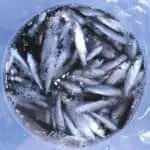As members of the same family with a similar appearance and shared habitat, what are the main differences between jack crevalle vs amberjack?
While both are members of the same family, differences in body shape, coloration, and size make it possible to tell the difference between amberjack and jack crevalle.
Table of Contents
- Why The Confusion?
- Differences Between Jack Crevalle And Amberjack
- Identification
- Final Thoughts
- Related Posts
Why The Confusion?
Amberjack and jack crevalle are both members of the family Carangidae but are separate species within that larger family.
Jack crevalle are in the genus Caranx, while amberjack are in the genus Seriola.
While there are many types of amberjack, the one that gets confused most often is the greater amberjack. It’s not surprising that these two fish can get confused because, in some regions, they are both referred to as trevally (which is another large species from the jack family).
The first and most obvious reason for the confusion is that both are Carangids (from the jack family) and they share the common body type with a similar shape and fin configuration. Additionally, they have similar coloring, which makes them easy to confuse at first glance.

They also share the same range, with both fish appearing much farther north in the summer months, then migrating south as the weather gets colder.
Amberjacks tend to live deeper, but juveniles spend some time inshore with jack crevalle.
Both species like similar structure, such as rocks, reefs and rubble.
Amberjacks are particularly well known for their love of shipwrecks but this applies to jack crevalle just as well. Both like to use barriers as aids to their hunting so they can commonly be found feeding in the same areas and living together.
Finally, both fish are known for their ability to give a fisherman a fight that’s much bigger than their size would indicate! Without a question, they are one of the hardest fighting fish for their size!
Differences Between Jack Crevalle And Amberjack
Size
While there’s a lot of overlap, amberjacks get much bigger than jack crevalle. Jack crevalle average 1-2 feet in length, and weigh between 3 and 8 pounds.
Larger jack crevalle can grow up to 3+ feet, and weigh up to 50 pounds!
By contrast, amberjacks are some of the biggest of all the jacks. Amberjack can grow to over six feet long and weigh up to 170 pounds.
It’s not uncommon to catch 30-50 pound amberjack on offshore reefs throughout Florida and the Gulf of Mexico.
Head Shape
The jack crevalle have a very distinctive, looming forehead. The head goes up very steeply from the nose to the top of its head in a very short distance. Once you’ve seen a jack crevalle’s head, it’s hard to mistake it for anything else.
Amberjack have a more tapered head which looks torpedo-shaped in their profile.
Color
Amberjack are either brownish or blueish gray on the back, turning to silver as you go lower on the body.
They have amber or yellow stripe running down the middle of their body, from eye to tail, and dark shading around the eye toward the midsection.
Jack Crevalle are more bronze or brown on the back, turning to silver and white on the lower body. One of the most distinctive color features of a jack crevalle is the yellow anal fin and yellow coloration in the tail.
Taste
It is important to be able to tell the difference between these fish. For one, local regulations may differ as to what you can take and how many, but it’s also important because there’s one you may want to eat and one you probably want to avoid!
Amberjack are commonly eaten and have a firm and mild-flavored meat. It has a similar consistency to swordfish with a buttery and salty flavor profile.
My favorite is grilled amberjack with country-style dijon! Delish!
Jack Crevalle, on the other hand, have a reputation as a fish you don’t want to eat, with dark red, oily, pungent, and extremely fishy meat.
They’re often called “garbage fish” and are considered fish that are a lot of fun to catch, but not worth taking home…
But don’t let that stop you from trying it! There is nothing wrong with eating jack crevalle, and plenty of anglers do if you are adventurous enough to try it!
Identification
Once you have landed your catch, how do you tell if you have a jack crevalle or amberjack?
The size will help somewhat with identification. If your catch is over two feet, the odds are pretty good that you have an amberjack. If it’s over four feet, you definitely don’t have a jack crevalle.
What are some ways to be completely sure whether you have a jack crevalle or amberjack?
How To Correctly Identify A Jack Crevalle
The head is probably the first indicator that you have a jack crevalle, along with the yellow fins and the Carangid body type.

Jack Crevalle also have a very noticeable black spot on both the base of the pectoral fins and on the gill cover.
While it’s only really a single fin, a jack crevalle’s dorsal fin is divided in such a way that it looks like it has two dorsal fins.
Finally, the jack crevalle has sharp plates called scutes around the bass of the tail that are actually capable of drawing blood if you aren’t careful!
How To Correctly Identify An Amberjack
Amberjacks have a slimmer and more torpedo-shaped body than a jack crevalle, which is much wider.
Amberjacks also have dark stripes that start above the eye and extend back to the dorsal fin. A jack crevalle is silver above the eyes.

In general, the amberjack is darker than the jack crevalle and lacks the tapered, yellow fins.
The single biggest difference between the two is the tail. The amberjack has a smooth tail, lacking the hard, bony plates that are the hallmark of the jack crevalle.
And, of course, the yellow or amber stripe that gives them their name and that runs from the eye to the tail is a very distinctive identifier.
While the amberjack also has a divided dorsal fin, it doesn’t give the two fin appearance of the jack crevalle dorsal fin.
Final Thoughts
Both the jack crevalle and amberjack are hard fighting fish that are an absolute blast to catch!
Generally speaking, jack crevalle are going to be found on the beaches, inshore or nearshore, and amberjack will generally be found nearshore or offshore (especially on wrecks and reefs).
One of the easiest ways to identify a Jack Crevalle from other species of jacks is the black spot on the pectoral fin, and bright yellow anal fin.
I hope this article helps you with your fish identification skills, thanks for reading!

Growing up in Florida, I’ve been surrounded by saltwater my entire life…and I love sharing my passion with others.
To learn more about why I started Saltwater Mecca, visit the ABOUT page.
Thank you for reading this article. Browse around & have some fun!





